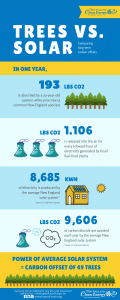Many of our customers choose to install solar paneling because they want to reduce their impact on the environment. That’s one reason we love solar, too! In terms of placement, you may be wondering if you can install solar in the shade. It may actually shock some people when we suggest removing a tree or two to improve solar production. So today we’re going to talk about tree mapping: why it’s necessary for the placement of your solar paneling, how we do it, and what it means for your carbon footprint.
What on earth is “tree mapping”? And how does it affect where I put my solar paneling?
Big trees near your roof can cast shadows on your solar system throughout the day and hamper your energy output. Tree mapping is the process of analyzing those trees and their projected shade to calculate potential impact on your solar system. This can get complicated quickly because the direction and amount of shade produced by a single tree depends on the time of day and time of year.
How do you know where to place the solar paneling?
We use a computer program called Aurora to map your solar system. Aurora provides us with a virtual space to analyze your roof’s dimensions and pitch as well as any possible challenges to electricity production (like trees). Using this information, we can plan the best configuration of panels for your home. And here’s the cool part: Aurora uses Light Detection and Ranging (LIDAR) data to map sunlight on your roof. LIDAR allows us to predict how much electricity your system will produce – all before stepping foot on your property.
If you decide to move forward with your project after seeing these initial plans, we’ll send one of our representatives to complete an in-person assessment. We’ll verify our data from Aurora and get a better look at potential sunlight obstructions. This reevaluation is especially important if you’ve recently removed trees or if your home is newly constructed (in which case it may not yet be visible on Aurora’s landscape imagery). If we feel your system could benefit from a little more sun, we’ll recommend you trim or fully remove a few trees.
“But trees are good for the environment, too!”
Yes, they are. And we understand your hesitation for removing them. But we’ve also done the math.
Back in 2015, I used data gathered by the U.S. Department of Energy (DOE) and the Environmental Protection Agency (EPA) to compare CO2 offsets of an eastern white pine tree and a typical New England solar system. Long story short, I found the average residential solar system (at 24 panels generating 7,848 watts) offsets 9,606 pounds of CO2 each year. That’s the equivalent to the carbon-sequestering power of 50 trees!
The average New England solar system offsets 9,606 lbs of CO2 per year… That’s equivalent to the annual carbon-sequestering power of 50 trees!
From a carbon offset standpoint, getting the solar paneling is a big win. If you are considering cutting down fewer than 50 trees to get the most out of a 7,500+ watt solar system, don’t feel guilty. On a net environmental basis, you are doing the right thing. Plus, we’ve never actually recommended someone cut down fifty trees; if shade is an issue, usually removing one or two will do the trick. In fact, we’ve installed hundreds of solar arrays that required no tree removal at all.
If we recommend tree removal for your solar project, remember you can always plant new ones elsewhere in your yard. Or you can find other eco-friendly ways to appreciate the newfound sunlight. One of our previous customers, Debby Andell of Acton, took down 11 towering pine trees to make way for solar: “we now have a more open back yard with renewed sun on our vegetable garden, and no more worries when wind storms are forecast!”
Ready to get started?
Click here to generate a free solar assessment for your home or contact us for more information.
If you liked this article, you may also like:



 Download our 7 FAQs
Download our 7 FAQs


No comments yet. You should be kind and add one!
The comments are closed.